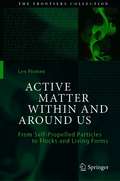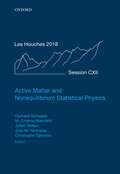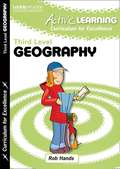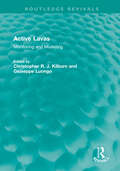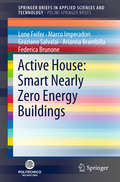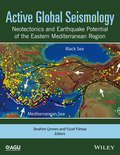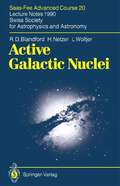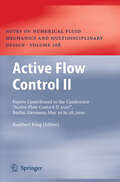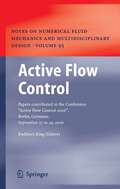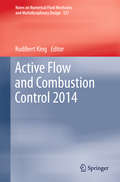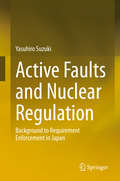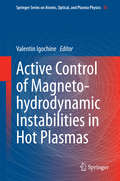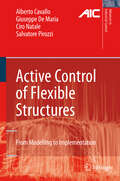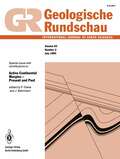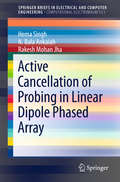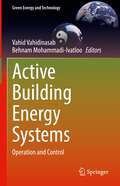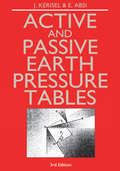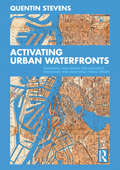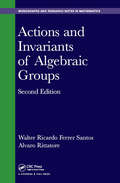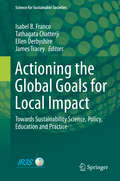- Table View
- List View
Active Matter Within and Around Us: From Self-Propelled Particles to Flocks and Living Forms (The Frontiers Collection)
by Len PismenThis book presents a comprehensive review of various aspects of the novel and rapidly developing field of active matter, which encompasses a wide variety of self-organized self-driven energy-consuming media or agents. Most naturally occurring examples are of biological origin, spanning all scales from intracellular structures to swimming and crawling cells and microorganisms, to living tissues, bacterial colonies and flocks of birds. But the field also encompasses artificial systems, from colloids to soft robots. Intrinsically out of equilibrium and free of constraints of time-reversal symmetry, such systems display a range of surprising and unusual behaviors. In this book, the author emphasizes connections between fluid-mechanical, material, biological and technological aspects of active matter. He employs a minimum of mathematical tools, ensuring that the presentation is accessible to a wider scientific community. Richly illustrated, it gives the reader a clear picture of this fascinating field, its diverse phenomena and its open questions.
Active Matter and Nonequilibrium Statistical Physics: Lecture Notes of the Les Houches Summer School: Volume 112, September 2018 (Lecture Notes of the Les Houches Summer School #112)
From molecular motors to bacteria, from crawling cells to large animals, active entities are found at all scales in the biological world. Active matter encompasses systems whose individual constituents irreversibly dissipate energy to exert self-propelling forces on their environment. Over the past twenty years, scientists have managed to engineer synthetic active particles in the lab, paving the way towards smart active materials. This book gathers a pedagogical set of lecture notes that cover topics in nonequilibrium statistical mechanics and active matter. These lecture notes stem from the first summer school on Active Matter delivered at the Les Houches school of Physics. The lectures covered four main research directions: collective behaviours in active-matter systems, passive and active colloidal systems, biophysics and active matter, and nonequilibrium statistical physics—from passive to active.
Active Learning — Active Geography: Third Level (PDF)
by Rob Hands Leckie Leckie StaffFocusing specifically on building skills – both geographical and higher order thinking skills – Active Geography covers the Third Level Outcomes and Experiences for geography in an engaging, activity-based way. Containing project ideas, co-operative learning tasks, literacy-based activities and games, it offers a toolkit of ideas to help you effectively implement Curriculum for Excellence with your class.
Active Lavas: Monitoring and Modelling (Routledge Revivals)
by Christopher R.J. Kilburn Giuseppe LuongoOriginally published in 1993, Active Lavas looks at the practical aspects of monitoring uncontrolled streams of molten rock and how field data can be applied for theoretical modelling and forecasting the growth of lava flows. It describes the basic features of common subaerial lava flows and domes – both on Earth and on other bodies in the Solar System – before discussing the logistics of measuring lava properties during eruption and how these measurements are used to develop simple theoretical models for forecasting flow behaviour.
Active Lavas: Monitoring and Modelling (Routledge Revivals)
by Christopher R. J. Kilburn Giuseppe LuongoOriginally published in 1993, Active Lavas looks at the practical aspects of monitoring uncontrolled streams of molten rock and how field data can be applied for theoretical modelling and forecasting the growth of lava flows. It describes the basic features of common subaerial lava flows and domes – both on Earth and on other bodies in the Solar System – before discussing the logistics of measuring lava properties during eruption and how these measurements are used to develop simple theoretical models for forecasting flow behaviour.
Active House: Smart Nearly Zero Energy Buildings (SpringerBriefs in Applied Sciences and Technology)
by Lone Feifer Marco Imperadori Graziano Salvalai Arianna Brambilla Federica BrunoneThe book provides an overview of the Active House (AH) vision, intended as a building design method “beyond” the passive approach for buildings of the future that will be more and more connected, smart and innovative. It offers a novel philosophical design approach in which buildings, new or renovated, are in balance with natural, renewable energies and become “concentrators-distributors” of energies instead of being consumers of resources. The book is composed of five chapters, providing information on fundamental aspects of innovations toward resource-efficient buildings, as well as case studies presenting the concept in practice. It demonstrates that a completely new design approach is possible, and that a turning point has been reached. Lastly, it shows how the AH Alliance, along with designers, institutions, industries and academies, is bringing a breath of fresh air to the world of construction.
Active Global Seismology: Neotectonics and Earthquake Potential of the Eastern Mediterranean Region (Geophysical Monograph Series #225)
by Ibrahim Cemen Yucel YilmazNeotectonics involves the study of the motions and deformations of the Earth's crust that are current or recent in geologic time. The Mediterranean region is one of the most important regions for neotectonics and related natural hazards. This volume focuses on the neotectonics of the Eastern Mediterranean region, which has experienced many major extensive earthquakes, including the devastating Izmit, Turkey earthquake on August 17, 1999. The event lasted for 37 seconds, killing around 17,000 people, injuring 44,000 people, and leaving approximately half a million people homeless. Since then, several North American, European, and Turkish research groups have studied the neotectonics and earthquake potential of the region using different geological and geophysical methods, including GPS studies, geodesy, and passive source seismology. Some results from their studies were presented in major North American and European geological meetings. This volume highlights the work involving the Eastern Mediterranean region, which has one of the world's longest and best studied active strike-slip (horizontal motion) faults: the east-west trending North Anatolian fault zone, which is very similar to the San Andreas fault in California. This volume features discussions of: Widespread applications in measuring plate motion that have strong implications in predicting natural disasters like earthquakes, both on a regional and a global scale Recent motions, particularly those produced by earthquakes, that provide insights on the physics of earthquake recurrence, the growth of mountains, orogenic movements, and seismic hazards Unique methodical approaches in collecting tectonophysical data, including field, seismic, experimental, computer-based, and theoretical approaches. Active Global Seismology is a valuable resource for geoscientists, particularly in the field of tectonophysics, geophysics, geodynamics, seismology, structural geology, environmental geology, and geoengineering. Read an interview with the editors to find out more:https://eos.org/editors-vox/neotectonics-and-earthquake-forecasting
Active Global Seismology: Neotectonics and Earthquake Potential of the Eastern Mediterranean Region (Geophysical Monograph Series #225)
by Ibrahim Emen Yucel YilmazNeotectonics involves the study of the motions and deformations of the Earth's crust that are current or recent in geologic time. The Mediterranean region is one of the most important regions for neotectonics and related natural hazards. This volume focuses on the neotectonics of the Eastern Mediterranean region, which has experienced many major extensive earthquakes, including the devastating Izmit, Turkey earthquake on August 17, 1999. The event lasted for 37 seconds, killing around 17,000 people, injuring 44,000 people, and leaving approximately half a million people homeless. Since then, several North American, European, and Turkish research groups have studied the neotectonics and earthquake potential of the region using different geological and geophysical methods, including GPS studies, geodesy, and passive source seismology. Some results from their studies were presented in major North American and European geological meetings. This volume highlights the work involving the Eastern Mediterranean region, which has one of the world's longest and best studied active strike-slip (horizontal motion) faults: the east-west trending North Anatolian fault zone, which is very similar to the San Andreas fault in California. This volume features discussions of: Widespread applications in measuring plate motion that have strong implications in predicting natural disasters like earthquakes, both on a regional and a global scale Recent motions, particularly those produced by earthquakes, that provide insights on the physics of earthquake recurrence, the growth of mountains, orogenic movements, and seismic hazards Unique methodical approaches in collecting tectonophysical data, including field, seismic, experimental, computer-based, and theoretical approaches. Active Global Seismology is a valuable resource for geoscientists, particularly in the field of tectonophysics, geophysics, geodynamics, seismology, structural geology, environmental geology, and geoengineering. Read an interview with the editors to find out more:https://eos.org/editors-vox/neotectonics-and-earthquake-forecasting
Active Galactic Nuclei: Saas-Fee Advanced Course 20. Lecture Notes 1990. Swiss Society for Astrophysics and Astronomy (Saas-Fee Advanced Course #20)
by R.D. Blandford H. Netzer L. WoltjerThe Swiss Society for Astrophysics and Astronomy organizes each year in the late winter or early spring an advanced course. The format of the school is always iden tical: three leading lecturers are invited to cover the subject in nine or ten lectures each and to deliver a written version of their lecture notes. Lectures are held in the morning and late afternoon, thus leaving ample time for discussion and skiing. These arrangements prove very convivial and lead to an excellent atmosphere in which to learn exciting new subjects and establish contacts with colleagues. A wide variety of people attend the school, including many young students, mostly from Europe, and some experienced researchers. The 20th Advanced Course of the Swiss Society for Astrophysics and Astronomy took place in Les Diablerets from 1 to 6 April 1990. It was devoted to observational and theoretical aspects of active galactic nuclei. The previous advanced courses of the Swiss Society for Astrophysics and Astronomy have regularly taken place in Saas-Fee, a small resort in the Swiss Alps, hence the name "Saas-Fee" used to de scribe the courses and lecture notes. In the last three years, however, the course was organized in Leysin and in Les Diablerets, both also situated in the Swiss Alps.
Active Flow Control II: Papers Contributed to the Conference “Active Flow Control II 2010”, Berlin, Germany, May 26 to 28, 2010 (Notes on Numerical Fluid Mechanics and Multidisciplinary Design #108)
by Rudibert KingThe interest in the field of active flow control (AFC) is steadily increasing. In - cent years the number of conferences and special sessions devoted to AFC org- ized by various institutions around the world continuously rises. New advanced courses for AFC are offered by the American Institute of Aeronautics and Ast- nautics (AIAA), the European Research Community on Flow, Turbulence and Combustion (ERCOFTAC), the International Centre for Mechanical Sciences (CISM), the von Karman Institute for Fluid Dynamics (VKI), to name just a few. New books on AFC are published by prominent colleagues of our field and even a new periodical, the ‘International Journal of Flow Control’, appeared. Despite these many activities in AFC it was felt that a follow-up of the highly successful ‘ACTIVE FLOW CONTROL’ Conference held in Berlin in 2006 was appropriate. As in 2006, ‘ACTIVE FLOW CONTROL II’ consisted only of invited lectures. To sti- late multidisciplinary discussions between experimental, theoretical and numerical fluid dynamics, aerodynamics, turbomachinary, mathematics, control engineering, metrology and computer science parallel sessions were excluded. Unfortunately, not all of the presented papers made it into this volume. As the preparation and printing of a book takes time and as this volume should be available at the conf- ence, the Local Organizing Committee had to set up a very ambitious time sch- ule which could not be met by all contributors.
Active Flow Control: Papers contributed to the Conference “Active Flow Control 2006”, Berlin, Germany, September 27 to 29, 2006 (Notes on Numerical Fluid Mechanics and Multidisciplinary Design #95)
by Rudibert KingThis book contains contributions presented at the Active Flow Control 2006 conference, held September 2006, at the Technische Universität Berlin, Germany. It contains a well balanced combination of theoretical and experimental state-of-the-art results of Active Flow Control. Coverage combines new developments in actuator technology, sensing, robust and optimal open- and closed-loop control and model reduction for control.
Active Flow and Combustion Control 2014 (Notes on Numerical Fluid Mechanics and Multidisciplinary Design #127)
by Rudibert KingThe book reports on the latest theoretical and experimental advances in the field of active flow and combustion control. It covers new developments in actuator technology and sensing, in robust and optimal open- and closed-loop control, as well as in model reduction for control. It collects contributions presented during the third edition of the Active Flow and Combustion Control conference, held in September 10-12, 2014 at the Technische Universität Berlin (Germany). This conference, as well as the research presented in the book, have been supported by the collaborative research center SFB 1029 -Substantial efficiency increase in gas turbines through direct use of coupled unsteady combustion and flow dynamics, funded by the DFG (German Research Foundation).
Active Faults and Nuclear Regulation: Background to Requirement Enforcement in Japan
by Yasuhiro SuzukiThis book reviews the active faults around nuclear power plants in Japan and recommends an optimal method of nuclear power regulation controlled by the Nuclear Regulation Authority of Japan. The active faults around nuclear power plants have been underestimated in Japan since the latter half of the 20th century. However, based on the lessons learned from the Fukushima nuclear power plant accident, the book sheds light on why the risks of active faults were underestimated, and discusses the optimal scientific method of assessing those risks. Further, the author shares his experiences in the new standard for nuclear regulation creation team and in the active fault survey at the Nuclear Regulation Authority of Japan. This book is a valuable resource for students, researchers, academic and policy-makers, as well as non-experts interested in nuclear safety.
Active Control of Magneto-hydrodynamic Instabilities in Hot Plasmas (Springer Series on Atomic, Optical, and Plasma Physics #83)
by Valentin IgochineDuring the past century, world-wide energy consumption has risen dramatically, which leads to a quest for new energy sources. Fusion of hydrogen atoms in hot plasmas is an attractive approach to solve the energy problem, with abundant fuel, inherent safety and no long-lived radioactivity. However, one of the limits on plasma performance is due to the various classes of magneto-hydrodynamic instabilities that may occur. The physics and control of these instabilities in modern magnetic confinement fusion devices is the subject of this book. Written by foremost experts, the contributions will provide valuable reference and up-to-date research reviews for "old hands" and newcomers alike.
Active Control of Flexible Structures: From Modeling to Implementation (Advances in Industrial Control)
by Alberto Cavallo Giuseppe de Maria Ciro Natale Salvatore PirozziA complete solution for problems of vibration control in structures that may be subject to a broadband primary vibration field, this book addresses the following steps: experimental identification of the dynamic model of the structure; optimal placement of sensors and actuators; formulation of control constraints in terms of controller frequency response shape; controller design and simulation; and controller implementation and rapid prototyping. The identification procedure is a gray-box approach tailored to the estimation of modal parameters of large-scale flexible structures. The actuator/sensor placement algorithm maximizes a modal controllability index improving the effectiveness of the control. Considering limitations of sensors and actuators, the controller is chosen as a stable, band-pass MIMO system resulting from the closed-form solution of a robust control problem. Experimental results on an aeronautical stiffened skin panel are presented using rapid-prototyping hardware.
Active Cancellation of Probing in Linear Dipole Phased Array (SpringerBriefs in Electrical and Computer Engineering)
by Hema Singh N. Bala Ankaiah Rakesh Mohan JhaIn this book, a modified improved LMS algorithm is employed for weight adaptation of dipole array for the generation of beam pattern in multiple signal environments. In phased arrays, the generation of adapted pattern according to the signal scenario requires an efficient adaptive algorithm. The antenna array is expected to maintain sufficient gain towards each of the desired source while at the same time suppress the probing sources. This cancels the signal transmission towards each of the hostile probing sources leading to active cancellation. In the book, the performance of dipole phased array is demonstrated in terms of fast convergence, output noise power and output signal-to-interference-and noise ratio. The mutual coupling effect and role of edge elements are taken into account. It is established that dipole array along with an efficient algorithm is able to maintain multilobe beamforming with accurate and deep nulls towards each probing source. This work has application to the active radar cross section (RCS) reduction. This book consists of formulation, algorithm description and result discussion on active cancellation of hostile probing sources in phased antenna array. It includes numerous illustrations demonstrating the theme of the book for different signal environments and array configurations. The concepts in this book are discussed in an easy-to-understand manner, making it suitable even for the beginners in the field of phased arrays and adaptive array processing.
Active Building Energy Systems: Operation and Control (Green Energy and Technology)
by Behnam Mohammadi-Ivatloo Vahid VahidinasabThis book provides a comprehensive study on state-of-the-art developments in the control, operation, and market participation of active buildings (ABs). Active buildings can support the broader energy system by intelligent integration of renewable-based energy technologies for heating, cooling, electricity, and transport. This important reference analyzes the key features of modern control and operation techniques applied to these systems. Contributions from an international team of experts present practical methods with evidence and case studies from applications to real-world or simulated active buildings. Sample computer codes and analytical examples aid in the understanding of the presented methods. The book will support researchers working on the control and operation of buildings as an energy system, smart cities and smart grids, and microgrids, as well as researchers and developers from the building and energy engineering, economic, and operation research fields.Provides an in-depth review of building-level energy systems technologies;Covers codes, standards, and requirements for active building control systems;Includes sample computer code and analytical examples.
Active and Passive Earth Pressure Tables
by E. AbsiThe problem of earth pressure on retaining structures is one of the oldest in soil mechanics. This volume comprises tables which facilitate calculations in problems of limit equilibrium. These tables provide coefficients which are extreme values in which the soil still is in equilibrium. They are or
Active and Passive Earth Pressure Tables
by E. AbsiThe problem of earth pressure on retaining structures is one of the oldest in soil mechanics. This volume comprises tables which facilitate calculations in problems of limit equilibrium. These tables provide coefficients which are extreme values in which the soil still is in equilibrium. They are or
Activating Urban Waterfronts: Planning and Design for Inclusive, Engaging and Adaptable Public Spaces
by Quentin StevensActivating Urban Waterfronts shows how urban waterfronts can be designed, managed and used in ways that can make them more inclusive, lively and sustainable. The book draws on detailed examination of a diversity of waterfronts from cities across Europe, Australia and Asia, illustrating the challenges of connecting these waterfront precincts to the surrounding city and examining how well they actually provide connection to water. The book challenges conventional large scale, long-term approaches to waterfront redevelopment, presenting a broad re-thinking of the formats and processes through which urban redevelopment can happen. It examines a range of actions that transform and activate urban spaces, including informal appropriations, temporary interventions, co-design, creative programming of uses, and adaptive redevelopment of waterfronts over time. It will be of interest to anyone involved in the development and management of waterfront precincts, including entrepreneurs, the creative industries, community organizations, and, most importantly, ordinary users.
Activating Urban Waterfronts: Planning and Design for Inclusive, Engaging and Adaptable Public Spaces
by Quentin StevensActivating Urban Waterfronts shows how urban waterfronts can be designed, managed and used in ways that can make them more inclusive, lively and sustainable. The book draws on detailed examination of a diversity of waterfronts from cities across Europe, Australia and Asia, illustrating the challenges of connecting these waterfront precincts to the surrounding city and examining how well they actually provide connection to water. The book challenges conventional large scale, long-term approaches to waterfront redevelopment, presenting a broad re-thinking of the formats and processes through which urban redevelopment can happen. It examines a range of actions that transform and activate urban spaces, including informal appropriations, temporary interventions, co-design, creative programming of uses, and adaptive redevelopment of waterfronts over time. It will be of interest to anyone involved in the development and management of waterfront precincts, including entrepreneurs, the creative industries, community organizations, and, most importantly, ordinary users.
Actions and Invariants of Algebraic Groups (Chapman & Hall/CRC Monographs and Research Notes in Mathematics)
by Walter Ricardo Ferrer Santos Alvaro RittatoreActions and Invariants of Algebraic Groups, Second Edition presents a self-contained introduction to geometric invariant theory starting from the basic theory of affine algebraic groups and proceeding towards more sophisticated dimensions." Building on the first edition, this book provides an introduction to the theory by equipping the reader with the tools needed to read advanced research in the field. Beginning with commutative algebra, algebraic geometry and the theory of Lie algebras, the book develops the necessary background of affine algebraic groups over an algebraically closed field, and then moves toward the algebraic and geometric aspects of modern invariant theory and quotients.
Actions and Invariants of Algebraic Groups (Chapman & Hall/CRC Monographs and Research Notes in Mathematics)
by Walter Ricardo Ferrer Santos Alvaro RittatoreActions and Invariants of Algebraic Groups, Second Edition presents a self-contained introduction to geometric invariant theory starting from the basic theory of affine algebraic groups and proceeding towards more sophisticated dimensions." Building on the first edition, this book provides an introduction to the theory by equipping the reader with the tools needed to read advanced research in the field. Beginning with commutative algebra, algebraic geometry and the theory of Lie algebras, the book develops the necessary background of affine algebraic groups over an algebraically closed field, and then moves toward the algebraic and geometric aspects of modern invariant theory and quotients.
Actioning the Global Goals for Local Impact: Towards Sustainability Science, Policy, Education and Practice (Science for Sustainable Societies)
by Isabel B. Franco Tathagata Chatterji Ellen Derbyshire James TraceyThis book highlights the value of sustainability science in newly emerging and innovative approaches to research, education, capacity building and practice in order to transform rhetoric into impact sustainability. Presenting case studies from various industries, sectors and geographical contexts targeting the seventeen (Sustainable development Goals (SDGs) outlined in the 2030 Agenda, it provides insightful recommendations to create sustainable impact while at the same time achieving the global goals. The book addresses the fundamental question of how sustainability rehtoric can be transformed into impact sustainability research, education and capacity building and as a result, how existing approaches in science, curricula and practice are mitigating the demands emerging from addressing global sustainable development in an impactful and innovative manner. Providing recommendations for impact sustainability in science, curriculum on how to address pressing sustainability issues and contribute toward achieving the SDGs, this book is an essential reference for both academics and professionals.
